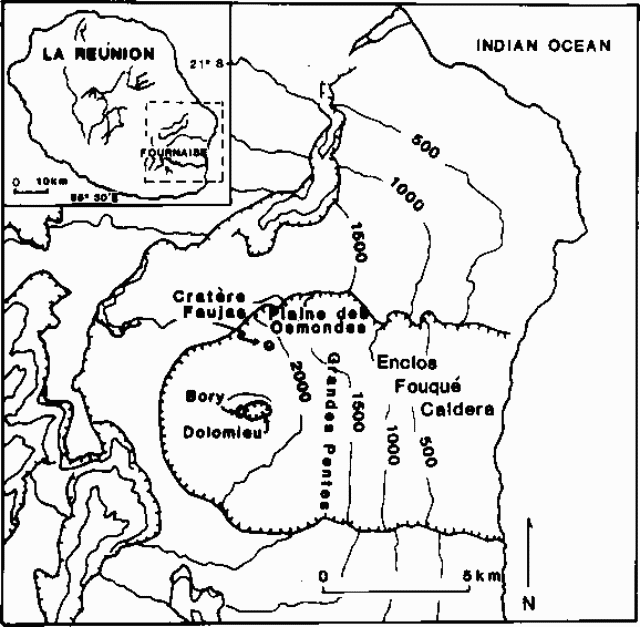Report on Piton de la Fournaise (France) — August 1985
Scientific Event Alert Network Bulletin, vol. 10, no. 8 (August 1985)
Managing Editor: Lindsay McClelland.
Piton de la Fournaise (France) Fissure activity resumes after 5-day hiatus
Please cite this report as:
Global Volcanism Program, 1985. Report on Piton de la Fournaise (France) (McClelland, L., ed.). Scientific Event Alert Network Bulletin, 10:8. Smithsonian Institution. https://doi.org/10.5479/si.GVP.SEAN198508-233020
Piton de la Fournaise
France
21.244°S, 55.708°E; summit elev. 2632 m
All times are local (unless otherwise noted)
"The eruptive episode that began on 5 August ended 1 September. The major part of the aphyric basalt lava flow was emitted during the first 10 days. The lava front stayed at the bottom of the Grandes Pentes inside the Plaine des Osmondes (near the N caldera wall, figure 13). During the last week, small amounts of pahoehoe were emitted from tunnels at the foot of Cratère Faujas, about halfway between the central cone and the N caldera wall. Seismic tremor lasted for 10 days at a very low level.
 |
Figure 13. Sketch map of the summit caldera region of Piton de la Fournaise after Blum and others (1981). |
"Deformation related to the opening of the 5 August fissure affected the summit and the flank of the Plaine des Osmondes. No significant deformation was recorded during August, but minor summit deflation was noted around the fissure zone.
Geological Summary. Piton de la Fournaise is a massive basaltic shield volcano on the French island of Réunion in the western Indian Ocean. Much of its more than 530,000-year history overlapped with eruptions of the deeply dissected Piton des Neiges shield volcano to the NW. Three scarps formed at about 250,000, 65,000, and less than 5,000 years ago by progressive eastward slumping, leaving caldera-sized embayments open to the E and SE. Numerous pyroclastic cones are present on the floor of the scarps and their outer flanks. Most recorded eruptions have originated from the summit and flanks of Dolomieu, a 400-m-high lava shield that has grown within the youngest scarp, which is about 9 km wide and about 13 km from the western wall to the ocean on the E side. More than 150 eruptions, most of which have produced fluid basaltic lava flows, have occurred since the 17th century. Only six eruptions, in 1708, 1774, 1776, 1800, 1977, and 1986, have originated from fissures outside the scarps.
Information Contacts: H. Delorme and J. Delarue, OVPDLF; P. Bachelery, Univ. de la Réunion.

